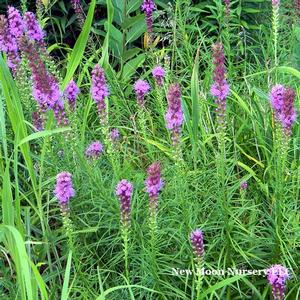Printed at http://www.newmoonnursery.com/index.cfm/
Liatris spicata
Dense blazing star
Native to North America
FIRST IMPRESSIONS: Liatris spicata is a handsome gayfeather with a tall unbranched habit. The stems are covered in attractive long narrow leaves. In summer foliage is topped by rosy-purple spiky flowers and surrounded by a bevy of butterflies. Plants prosper in sunny sites with moist soil.
HABITAT & HARDINESS: Liatris spicata occurs in Ontario and Quebec, from Massachusetts to Florida and west to Wisconsin and Louisiana.
Plants are indigenous to moist prairies, Blackland prairies, edges of bogs and marshes, calcareous seeps, moist alkaline sandflats and sunny moist rights-of-way. This species occasionally forms colonies in high quality moist sandy natural areas.
Plants are hardy from USDA Zones 3-9.
PLANT DESCRIPTION: Liatris spicata is a robust perennial that produces an upright central stalk from a rounded woody underground corm. Foliage is long, narrow and either glabrous or peppered with sparse hairs. The largest basal leaves are almost 1/2” wide and 10” long. Blades become progressively smaller as the stalk rises. They are deep green with a distinct main vein and are arranged close together on the stem.
Foliage is topped by spikey wand-like inflorescences composed of many orchid colored florets. The florets are crowded into 1/2” button-like heads. Each head contains 4-10 disc florets with curly exerted styles.
Blooming begins at the top of the flower stalk and progresses downward. The floral display commences in mid-summer and lasts for 3-4 weeks. Flower heads mature into soft tufts of fluffy golden brown achenes.
Plants are up to 6’ tall but commonly reach 3-4’ with a 1-2’ spread. Height is quite variable depending on soil moisture and fertility.
CULTURAL & MAINTENANCE NEEDS: Liatris spicata flourishes in sunny sites with moist humus rich sandy loams.
Plants tolerate heavier loams, clay, gravelly or calcareous soils. They also prosper in heat, humidity and drought.
During extended hot dry weather lower leaves may wither. In garden soils organic matter can be added to help retain moisture.
Rabbits, deer and livestock nibble the foliage and stems. The corms are a favored food of meadow voles or prairie voles. A large population of these rodents can decimate a stand of this lovely wildflower.
LANDSCAPE USES: This species adapts easily to sunny gardens with average soil. Plants are used most often to inject a strong vertical Accent or as Groupings or Mass plantings for Wildlife Gardens or Perennial Borders. Liatris spicata has Showy Blooms that serve as long lasting Cut Flowers. Plants are appropriate for Butterfly Gardens, Cottage Gardens, Water-wise Landscapes, Low Maintenance Plantings, moist Prairies or Meadows, margins of Water Gardens, Rain Gardens and Roadsides.
COMPANION & UNDERSTUDY PLANTS: Try pairing Liatris spicata with Andropogon gerardii, Anemone canadensis, Aster novae-angliae, Aster puniceus, Echinacea purpurea, Eupatorium hyssopifolium, Helenium autumnale or Heliopsis helianthoides.
In a dry site, Liatris aspera could be a suitable replacement due to similar flowers and blooming time.
TRIVIA: Liatris spicata prefers wetter habitats than most other blazing stars. It can be distinguished from its relatives by its denser flower spikes, smooth un-recurved floral bracts, and tall stature.
This member of the Sunflower Family is also known as Marsh Blazing Star or Spike Gayfeather.
Liatris spicata attracts beneficial bees, skippers, butterflies, hummingbird moths and hummingbirds. Birds feed on the seed during autumn.
Height:
3-6 ftSpread:
2 ftSpacing:
2-3 ftUSDA Hardiness Zone:
3-9Bloom Color:
Purple, Purple RedLiatris spicata Characteristics
Attracts Wildlife
- Songbirds
- Pollinators
- Butterflies
Attributes
- Drought Tolerant
- Cut Flower
- Clay Soil
Exposure
- Full Sun
Deer Resistant
- Deer Resistant
Flowering Months
- August
- July
Foliage Color
- Green
Growth Rate
- Medium
Salt Tolerance
- Medium
Season of Interest (Foliage)
- Spring
- Summer
Soil Moisture Preference
- Moist to Wet
Interesting Notes:
For more information on this plant, visit the USDA PLANTS Database: http://plants.usda.gov/java/profile?symbol=LISP

